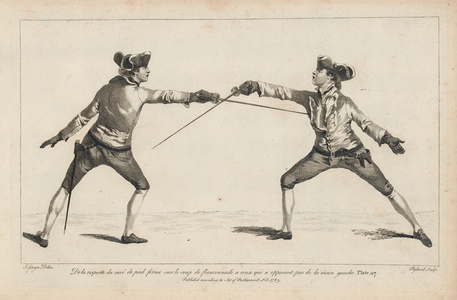| Method | Copper engraving and etching |
| Artist | Ryland after James Gwin |
| Published | Publish'd according to Act of Parliament. Feb,, 1763. |
| Dimensions | Image 230 x 403 mm, Plate 263 x 415 mm, Sheet 310 x 485 mm |
| Notes |
Plate 27 from Domenico Angelo's 'L'école Des Armes avec l'explication générale des principales attitudes et positions concernant l'escrime' or 'The School Of Weapons with a general explanation of the main attitudes and positions concerning fencing'. The 47 plates in the series demonstrate various fencing positions including postures, walking steps, lunges, and defences. During the eighteenth-century, fencing was a popular sport among the English royalty and aristocracy, primarily learned on the Continent until the Italian fencing master Domenico Angelo Malevolti Tremamondo (1716 - 1802) established his fencing school in London. A riding instructor by trade, Angelo was born in Leghorn, Italy in 1716 and briefly trained with the celebrated fencer Monsieur Teillagory in Paris. After arriving in England in 1755, he participated in and won several public fencing matches, quickly earning a reputation that helped him secure high-ranking clients such as the Duke of Devonshire and the Earl of Pembroke. He soon capitalized on his popularity by establishing Angelo's School of Arms, where he taught horsemanship as well as fencing to an affluent and fashionable clientele. Angelo also continued to teach privately and in 1758, instructed the Prince of Wales and the Duke of York. Over the years, his school became a venerable British institution, which was run by successive generations of the Angelo family until the early twentieth-century. In 1763, Angelo published L'Ecole des Armes Avec l'explication génèrale des principales attitudes et positions concernant l'Escrime illustrated with forty-seven copper-plates by famous English artists Gwynn and Ryland, Hall, Chamber and Grignion. Angelo himself, as he noted in his letter, posed as one of the combatants in the plates and his friend and patron Henry Herbert, the 10th Earl of Pembroke (1734-1794), often posed as his opponent. The special presentation copy of the original drawings was later acquired by Lord Farnham. In 1961, it was sold at Sotheby's to Paul Mellon, and is now in the Yale Center for British Art. The Royal Library at Windsor has a proof set of Angelo's plates commissioned in 1765 for inclusion in Diderot's encyclopedia. The plates are prefaced by a manuscript dedication by Angelo to the Prince of Wales. Attributed to Joseph Ryland (1738 - c.1791) a British engraver and printmaker. It is likely that he was one of the seven sons of the engraver and copper-plate printer, Edward Ryland (c.1709 - 1771). The most well known son of the Ryland family was William Wynne Ryland, who was found guilty of forgery and became the last man hanged at Tyburn in 1783. James Gwin [Gwim, Gwyn] (c.1700 - 1769) was a Scottish designer and engraver. Born in Kildare, he worked as an engraver in Dublin from c.1719 before moving to London in the 1740's where he worked on many designs and engravings for the publisher Bowles. Whilst in London Gwin changed his surname from 'Gwim' to 'Gwin', but he also signed many designs as 'Gwyn'. Condition: Toning to sheet edges. Light foxing to sheet. Small spot of rust to centre of image. Binding holes to left sheet edge. Vertical fold to left sheet edge. |
| Framing | unmounted |
| Price | £200.00 |
| Stock ID | 53317 |

